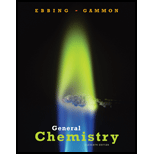
Concept explainers
(a)
Interpretation:
The given equation has to be written complete and balanced
Concept Introduction:
Balanced Chemical equation:
A balanced chemical equation is an equation which contains same elements in same number on both the sides (reactant and product side) of the chemical equation thereby obeying the law of conservation of mass.
To Write: The given equation complete and balanced.
(a)
Answer to Problem 21.126QP
The complete and balanced equation of the given equation is:
Explanation of Solution
Given Equation:
Complete Equation:
A complete equation will have same present on both sides of the equation.
The above equation can be completed by writing as follows,
Balancing the equation:
A balanced equation will have same elements and same number of atoms of each side of the reaction.
List the atoms of the equation in a table and check for the equal number of atoms present on either side of the reaction.
| Reactant side | Atom | Product side |
| 3 |
|
3 |
| 5 |
|
5 |
| 5 |
|
5 |
| 1 |
|
1 |
The number of atoms on both sides of the reaction are same. Therefore, the above equation is a balanced one.
Hence, the complete and balanced form of the given equation is written as:
The complete and balanced equation of the given equation is written as:
(b)
Interpretation:
The given equation has to be written complete and balanced
Concept Introduction:
Balanced Chemical equation:
A balanced chemical equation is an equation which contains same elements in same number on both the sides (reactant and product side) of the chemical equation thereby obeying the law of conservation of mass.
To Write: The given equation complete and balanced.
(b)
Answer to Problem 21.126QP
The complete and balanced equation of the given equation is:
Explanation of Solution
Given Equation:
Complete equation:
A complete equation will have same present on both sides of the equation.
The above equation can be completed by writing as follows,
Balancing the equation:
A balanced equation will have same elements and same number of atoms of each side of the reaction.
List the atoms of the equation in a table and check for the equal number of atoms present on either side of the reaction.
| Reactant side | Atom | Product side |
| 2 |
|
1 |
| 8 |
|
4 |
| 3 |
|
2 |
| 2 |
|
1 |
Multiply both the products on the product side by two and balance the equation again.
Again, list the atoms of the equation in a table and check for the equal number of atoms present on either side of the reaction.
| Reactant side | Atom | Product side |
| 2 |
|
2 |
| 8 |
|
8 |
| 4 |
|
4 |
| 2 |
|
2 |
The number of atoms on both sides of the reaction are same. Therefore, the above equation is a balanced one.
Hence, the complete and balanced form of the given equation is written as:
The complete and balanced equation of the given equation is written as:
Want to see more full solutions like this?
Chapter 21 Solutions
General Chemistry
- 3. For questions 1-4, consider the following complexes: [Co(CN)6]4, [COC14]², [Cr(H2O)6]²+ Which (if any) of these complexes would be expected to display Jahn-Teller distortion? (2 points)arrow_forwardWhat is Instrumental Neutron Activation and what are the advantages and disadvantages in using its applications? (I'm doing an in class assignment and need better understanding of what the instrument can be used for) Please include references so that I can better understand the application of how the instrument works!arrow_forwardWhat is Isotope Analysis and what are the advantages and disadvantages in using its applications and instrumentalization? Please include references so that I can better understand how the instrument works!arrow_forward
- 5. Count the electrons on the following complexes and state whether they follow the 18- electron rule: (3 points) Fe(CO)5 Ni(PMe3)4 PMe3 is trimethylphosphine Mn(CO)5Brarrow_forwardFor questions 1-4, consider the following complexes: [Co(CN)6]+, [CoCl4]², [Cr(H2O)6]²+ 2. Draw the corresponding d-orbital splitting for each of the complexes; predict the spin- state (low-spin/high spin) for each of the complexes (if applicable); explain your arguments. Calculate the crystal field stabilization energy for each complex (in Ao or At). (6 points)arrow_forwardFor questions 1-4, consider the following complexes: [Co(CN)6]4, [COC14]², [Cr(H2O)6]²+ 1. Assign oxidation number to the metal, then indicate d-electron count. (3 points)arrow_forward
- Using iodometry I want to titrate a sodium thiosulfate solution and I use 15 mL. If I have 50 mL of a 0.90 M copper solution and KI, what will be the molarity of sodium thiosulfate?arrow_forwardDraw the product formed when the following pair of compounds is treated with NaOEt in ethanol. + i CNarrow_forwardI need help with the followingarrow_forward

 Introductory Chemistry: A FoundationChemistryISBN:9781285199030Author:Steven S. Zumdahl, Donald J. DeCostePublisher:Cengage Learning
Introductory Chemistry: A FoundationChemistryISBN:9781285199030Author:Steven S. Zumdahl, Donald J. DeCostePublisher:Cengage Learning General, Organic, and Biological ChemistryChemistryISBN:9781285853918Author:H. Stephen StokerPublisher:Cengage Learning
General, Organic, and Biological ChemistryChemistryISBN:9781285853918Author:H. Stephen StokerPublisher:Cengage Learning Chemistry: Principles and PracticeChemistryISBN:9780534420123Author:Daniel L. Reger, Scott R. Goode, David W. Ball, Edward MercerPublisher:Cengage Learning
Chemistry: Principles and PracticeChemistryISBN:9780534420123Author:Daniel L. Reger, Scott R. Goode, David W. Ball, Edward MercerPublisher:Cengage Learning ChemistryChemistryISBN:9781305957404Author:Steven S. Zumdahl, Susan A. Zumdahl, Donald J. DeCostePublisher:Cengage Learning
ChemistryChemistryISBN:9781305957404Author:Steven S. Zumdahl, Susan A. Zumdahl, Donald J. DeCostePublisher:Cengage Learning Chemistry: An Atoms First ApproachChemistryISBN:9781305079243Author:Steven S. Zumdahl, Susan A. ZumdahlPublisher:Cengage Learning
Chemistry: An Atoms First ApproachChemistryISBN:9781305079243Author:Steven S. Zumdahl, Susan A. ZumdahlPublisher:Cengage Learning





